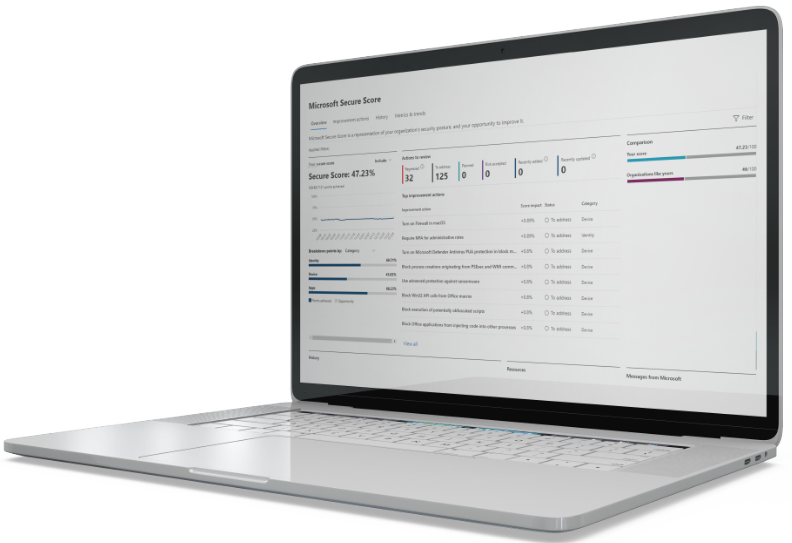
How to Secure Your Office 365 Emails
Email security is a critical concern for businesses. It's the frontline in protecting sensitive information. Office 365, a popular platform, offers strong built-in security features. But is that enough?
Common threats like phishing, malware, and spoofing are ever-evolving. They pose a constant challenge to Office 365 users.
This guide aims to help you enhance your Office 365 email security. It provides actionable advice on best practices and tools to secure your email environment. From multi-factor authentication to anti-phishing policies, we'll explore various strategies. We'll also delve into advanced measures for added protection.
Understanding Office 365 Email Security
Office 365 email security encompasses multiple layers of protection. These layers are designed to safeguard your data and communications. Understanding these layers is crucial for effective management.
Each security measure in Office 365 works to counteract various threats. These include unauthorized access and data breaches. By using these features wisely, you can significantly enhance your email security.

Built-in Security Features of Office 365
Office 365 offers several built-in features focused on email security. These features help to keep your communications safe.
- Spam Filtering: Reduces unwanted and potentially harmful emails.
- Anti-Phishing Technologies: Protect against deceitful email scams.
- Data Encryption: Ensures data privacy in transit and at rest.
- Data Loss Prevention: Prevents accidental leaks of sensitive information.
These built-in tools provide a strong baseline for security. However, understanding and configuring them correctly is essential.

.jpg?width=1500&height=1000&name=hacker-woman-launching-cyberattack-bank-firewall-from-home-during-night-time-programmer-writing-dangerous-malware-cyber-attacks-using-performance-laptop-during-midnight%20(1).jpg)
Common Email Threats in Office 365
Office 365 users face various email threats. Recognizing these threats is the first step in combating them.
Phishing attacks are among the most prevalent threats. They aim to trick users into revealing sensitive information. Malware is another common threat, often delivered via email attachments.
Spoofing attacks involve sending emails from false addresses. These aim to trick recipients into trusting malicious messages.
Key threats include:
- Phishing: Fraudulent attempts to obtain sensitive data.
- Malware: Software designed to damage or disrupt systems.
- Spoofing: Fake identities used to deceive recipients.
Awareness of these threats is vital. Educating users and implementing strong security measures can mitigate risks significantly.
Best Practices for Office 365 Email Security
Adopting best practices is essential for securing your Office 365 emails. These practices help mitigate risks and enhance protection.
Proactive security measures can prevent many common threats. Regular monitoring and updates are equally important.
Here are some key practices to secure your emails effectively.
Implementing Multi-Factor Authentication (MFA)
Multi-Factor Authentication is a crucial security measure. It adds an extra layer of protection beyond passwords.
With MFA, users provide additional verification, like a code sent to a mobile device. This makes unauthorized access more challenging. Implementing MFA can significantly reduce the risk of email breaches. To find out more about MFA, the type that is best for your business and what it costs to implement check out our page all about MFA.
Strong Password Policies and Regular Changes
Strong password policies play a vital role in email security. Use passwords that are complex and hard to guess.
Encourage regular password changes to improve security further. Frequent changes reduce the risk if passwords are compromised. Emphasize creating passwords that combine letters, numbers, and symbols.
Utilizing Advanced Threat Protection (ATP)
Advanced Threat Protection offers robust defenses against sophisticated threats. ATP scans emails for malicious links and attachments. It provides real-time protection by identifying threats before they reach users. By utilizing ATP, you enhance your defenses against evolving threats. ATP helps keep your email environment safe and secure.
Setting Up Anti-Phishing Policies
Anti-phishing policies are crucial in preventing deceitful attacks. These policies identify and block phishing attempts. Customize policies based on organization-specific threats and patterns. Regularly update them to tackle new phishing tactics. Effective policies can reduce successful phishing attacks significantly.
Regular Software Updates and Patching
Keep software updated to guard against vulnerabilities. Regular updates ensure your systems have the latest security enhancements.
Patching is vital for addressing known security gaps. Neglecting updates can expose your organization to unnecessary risks. Schedule regular checks to stay ahead of potential threats.
Email Encryption Strategies
Email encryption protects data both in transit and at rest. It ensures only intended recipients can read the message content.
Implementing encryption can prevent unauthorized data access. Consider using Office 365's built-in encryption tools. Encryption is fundamental in maintaining privacy and compliance.
Data Loss Prevention (DLP) Policies
DLP policies help safeguard sensitive information from accidental sharing. They identify and block unauthorized data transfers.
Configure DLP to alert users when they attempt to send protected data. This helps enforce policies and prevent data leaks. Effective DLP strategies protect both your data and reputation.
Audit Logs and Reporting
Audit logs are essential for monitoring and detecting unusual activities. They provide insights into email access and changes. Regularly reviewing logs helps identify suspicious behavior early. Reporting can aid in evaluating security measures' effectiveness. Consistent monitoring is key to maintaining Office 365 email security.
Enhancing Office 365 Security Beyond the Basics
To fortify Office 365 security, moving beyond basic measures is crucial. This involves adopting advanced tools and practices. Integrating these advanced strategies helps combat sophisticated threats. Let's explore several methods to strengthen your email security framework.
Secure Email Gateways and Secure Score
Secure Email Gateways protect against threats before they enter your network. They filter emails for spam, phishing, and malware.
Secure Score in Office 365 provides insights into your security posture. It offers recommendations for improving security measures. Leveraging these tools enhances your ability to detect and prevent attacks. They help maintain a robust email security environment. To view your Microsoft Secure Score, go to: https://security.microsoft.com/securescore.
Mail Flow Rules Configuration
Configuring mail flow rules can control the movement of emails. Proper rules ensure emails are monitored and routed securely These rules can also prevent data leaks and unauthorized forwarding. Regularly review and update them based on organizational needs.
Effective mail flow rules enhance control over email traffic, boosting security. They support maintaining compliance and data integrity.
The Importance of Regular Backups
Regular data backups are essential for disaster recovery. They ensure that you can restore important emails and documents. Backups can mitigate damage from ransomware attacks and data corruption. Schedule frequent backups to ensure minimal data loss.
Maintaining regular backups is an integral part of a comprehensive security strategy. They provide peace of mind and operational continuity.
Recognizing and Responding to Compromised Accounts
Recognizing compromised accounts quickly limits damage. Warning signs include unusual login locations and unexpected changes.
Immediate response is key, which involves resetting passwords and investigating breaches. Ensure recovery protocols are in place. Recognizing compromises early reduces the risk to your organization. Being prepared enhances overall security resilience.
Incident Response Planning
Incident response planning prepares you for security breaches. A robust plan includes response procedures and communication strategies.
Regularly test and update your plan to address emerging threats. Training staff on their roles can improve response effectiveness. Having a structured incident response plan minimizes damage during an attack. It helps ensure a swift return to normalcy.
Creating a Culture of Security Awareness
A security-aware culture empowers employees to be the first line of defense. Regular training and updates keep security top of mind.
Encourage staff to report suspicious activities without hesitation. Awareness reduces risk by minimizing human error and negligence. By fostering a security-focused culture, you enhance organizational resilience. It creates a proactive approach to email security.
Maintaining Vigilance in Email Security
Email security for Office 365 demands ongoing diligence. It's not a one-time task but a continuous process of improvement. By implementing best practices and utilizing advanced security tools, you can fortify your organization against threats. Staying informed about the latest cyber threats and adapting to new technologies is essential.
Security awareness and regular training are pivotal in maintaining a robust defense. Instilling a proactive mindset within your team reduces risks and enhances protection. Regularly review your security measures to ensure they're up-to-date and effective.
With vigilance and commitment, your organization's email environment can remain secure and resilient. Continuous improvement is key to safeguarding sensitive information and maintaining operational integrity.
We can help manage your licensing and decide what layers to put in place to secure your email.

Go to Our Guide to Cybersecurity for Small Business
Want to know more about how we can help secure your email, what is involved and what are the costs? Schedule a call with us.
.webp?width=214&height=138&name=cyber-security-guide-1%20(1).webp)